Coin search results - "classical gold"
|
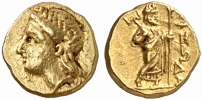
(BC 340-334) Pixodaros - AV 1/12 Stater1845 viewsPixodaros, Satrap, 340-334 BC. AV 1/12 Stater - Obol (7mm, 0.63g, 12h). Halikarnassos mint. Laureate head of Apollo left / ΠΙΞΟΔΑΡΟΥ, Zeus Labraundos standing right, holding labrys and lotus-tipped scepter. EF. Rare. Karl Coll.; Ex Hirsch Auk. 177 (2/1993), lot 373.
|
|
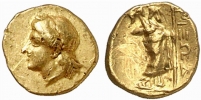
(BC 340-334) Pixodaros - AV 1/12 Stater1062 viewsPixodaros, Satrap, 340-334 BC. AV 1/12 Stater - Obol (8mm, 0.67g, 12h). Halikarnassos mint. Laureate head of Apollo left / Zeus Labraundos standing right, holding labrys and lotus-tipped scepter, ΠΙΞΟΔΑΡΟΥ to right. Pits and scratches, VF. Rare. Karl Coll.
|
|
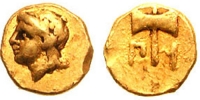
(BC 340-334) Pixodaros - AV 1/24 Stater1209 viewsPixodaros, Satrap, 340-334 BC. AV 1/24 Stater - Hemiobol (0.35g). Laureate head of Apollo left / Double axe (labrys), Π−Ι. VF. Very rare. Drewry Coll.
|
|
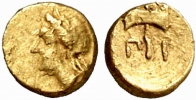
(BC 340-334) Pixodaros - AV 1/24 Stater740 viewsPixodaros, Satrap, 340-334 BC. AV 1/24 Stater - Hemiobol (6mm, 0.36g, 12h). Halikarnassos mint. Laureate head of Apollo left / Double axe (labrys), Π−Ι. Weak strike and pits on obv, VF. Rare. Karl Coll.; ex Hirsch Auk. 231 (11/2003), lot 365.
|
|
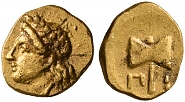
(BC 340-334) Pixodaros - AV 1/24 Stater372 viewsPixodaros, Satrap, 340-334 BC. AV 1/24 Stater - Hemiobol (0.32g, 6mm, 4h). Halikarnassos mint. Laureate head of Apollo left / Double axe (Labrys), Π−Ι flanking handle. gVF, well preserved for issue, possibly second best known [cf Roma Numismatics E-Sale 55 (4/2019), lot 384] – most other examples with reverse lettering off the flan. Very rare, 6 recorded in CoinArchives. Carr coll.
|
|
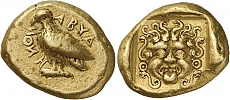
Abydos (BC 470-450) AV Stater6496 viewsca 410 BC. AV Stater (8.58g). ABYΔ/HNON (the lower part of the legend retrograde), eagle standing left / Gorgoneion facing, within an incuse square. Light scrape on reverse edge at 5 o’clock. VF/gVF. Unique and of great importance. Ex ‘Kunstfreund’ Coll., Bank Leu AG & Münzen und Medaillen AG (Zurich, 5/1974), lot 161; ex Monnaies et Médailles SA, Auc. 53 (Basel, 11/1977), lot 92.
Abydos was a colony of Miletos, situated on the Hellespont, and was perhaps an early location of the minting of electrum staters in the sixth century B.C. The city had been part of the Athenian empire during the fifth century until it revolted in 411 B.C., becoming a Spartan ally. This incredible gold stater, the only known example, is of the highest numismatic importance.
|
|
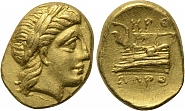
Kios (BC 350-300) AV 1/6 Stater - Herodoros810 viewsca 350-300 BC. AV 1/4 Siglos (1.43g, 10mm). Herodoros, magistrate. Laureate head of Apollo right / HPO / ΔΩΡΟΣ, prow left. gVF. Extremely rare denomination.
|
|
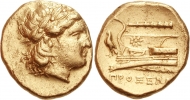
Kios (BC 350-300) AV Stater - Proxenos1349 viewsca 350-300 BC. AV Stater (8.60g, 12h). Proxenos, magistrate. Head of Apollo right, wearing laurel wreath / Prow of galley left, decorated with star; above, club right; to left, eagle standing left; ΠPOΞENO[Σ] below. Good VF, some die rust, obverse a little off center. Extremely rare. This magistrate is only known on two examples of Kios staters, both in museums (Paris and Berlin).
|
|

Kios (BC 350-300) AV Stater - Proxenos1329 viewsca 350-300 BC. AV Stater (17mm, 8.53g, 1h). Proxenos, magistrate. Head of Apollo right, wearing laurel wreath / Prow of galley left, decorated with star; above, club right; to left, eagle standing left; ΠPOΞENOΣ below. VF. Well centered. Very rare.
|
|
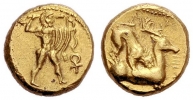
Kition (BC 361-312) AV 1/2 Stater - Pumiathon1222 viewsPumiathon, King of Kition, ca 361-312 BC. AV Hemistater (4.15g). Herakles advancing right, club in right hand, bow in left hand draped with lion's skin; ankh symbol to right / Lion attacking stag, in Cypriot 'mlk pmjtn' above; to right, date IIII− (= Year 14). EF. Very rare. Ex Berry and P.A. Coll.; Münzen und Medaillen AG 586 (1995), 19; Numismatic Fine Arts (1987), 228 and Hess-Divo AG 307 (2007), 1294.
|
|
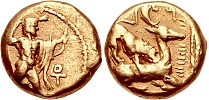
Kition (BC 361-312) AV 1/2 Stater - Pumiathon977 viewsPumiathon, ca 362-312 BC. AV Hemistater (12mm, 4.11g, 6h). Dated RY 8 (355/4 BC). Herakles advancing right, holding club, bow, and arrow, lion skin draped over arm; ankh to right / Lion right, biting into the back of a stag recumbent right; ‹‹‹‹‹‹‹‹ (8 = date) to right. Near VF, a little off center, typical compact flan. Rare, and the only example with the year 8 date fully visible.
|
|
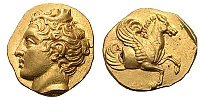
Lampsakos (BC 394-330) AV Stater - Aktaion2560 viewsca 394-350 BC. AV Stater (8.45g). Head of Aktaion left, with stag's horn / Forepart of Pegasos right. Mint state.
|
|
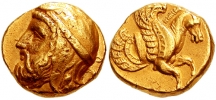
Lampsakos (BC 394-330) AV Stater - Artabazos5804 viewsArtabazos, Satrap of Daskylion. ca 356 BC. AV Stater (8.45g). Head of Artabazos left, wearing a Persian tiara tied with a diadem / Forepart of Pegasos right. Good VF, light roughness on the obverse. Very rare, only six recorded examples, four of which are in museum collections. Ex Leu 30 (4/1982), lot 167; Von Aulock Collection, 7395; Monnaies et Medailles XIX (6/1959), lot 475; Muenzen und Medaillen XIII (6/1954), lot 1159.
|
|
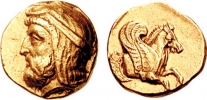
Lampsakos (BC 394-330) AV Stater - Artabazos3172 viewsArtabazos, Satrap of Daskylion, ca 356 BC. AV Stater (8.46g, 3h). Head of Artabazos left, wearing a Persian tiara tied with a diadem / Forepart of Pegasos right in shallow incuse. Good VF, a few light scratches. Extremely rare, only six examples recorded, four of which are in museum collections.
Traditionally, this stater has been assigned to the satrap Orontes, based on the similarity of its reverse to silver and bronze coins believed to have been struck by him at Lampsakos. Although Orontes did control portions of Mysia, he was in fact subordinate to his kinsman Artabazos who was the true satrap of the entire region of Daskylion, which encompassed Lampsakos at the time this coin was struck. When both Orontes and Artabazos rebelled against the Persian king Artaxerxes III in 357 BC, Artabazos secured Lampsakos through the agency of the hired Athenian mercenary, Chares. When Chares accomplished his mission, Artabazos richly rewarded him in coin, the likely occasion for striking this issue.
|
|
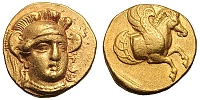
Lampsakos (BC 394-330) AV Stater - Athena1574 viewsca 400-370 BC. AV Stater (8.40g). Three-quarter facing head of Athena, wearing crested Attic helmet with cheek pieces turned up and necklace / Forepart of Pegasos to right. About EF.
|
|
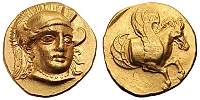
Lampsakos (BC 394-330) AV Stater - Athena1744 viewsCa. 394-350 BC. AV Stater (8.44g). Head of Athena three-quarters right in triple-crested helmet with raised ear flaps, wearing pendant earring and pearl necklace / Forepart of winged horse monster right. Very rare. EF. Ex Numismatica Ars Classica 23 (3/2002), lot 1243.
|
|
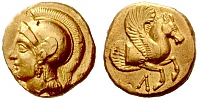
Lampsakos (BC 394-330) AV Stater - Athena1417 viewsca 394-350 BC. AV Stater (16mm, 8.42g). Helmeted head of Athena left / Forepart of Pegasus right, Λ below. Extremely rare. Two very minor nicks (one on obverse and one on reverse) and some abrasion on edge, otherwise aEF.
|
|
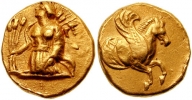
Lampsakos (BC 394-330) AV Stater - Demeter2752 viewsca 370 BC. AV Stater (8.35g), Persic standard. Half length figure of Demeter, wearing girdled chiton and himation, rising left from earth, holding three ears of grain; behind left shoulder, two ears of grain and vine bearing two bunches of grapes / Forepart of winged horse right with curved wing. Good VF. Extremely rare, only two known specimens, this being the only one in private hands. Ex Gillet Coll.; Weber Coll., 5096.
Following the example and standard of the Persic daric, Lampsakos was the first Greek city to make regular issues of gold coinage which enjoyed an international circulation from Sicily to the Black Sea. As at Kyzikos, the quality of engraving was very high, and types changed frequently: about forty types were produced in a period of about sixty years, one of the most interesting of which is the highly original rendering of Demeter Chthonia rising from the ground. Chthonic deities were those whose powers came from the earth. An important aspect of Demeter celebrated in the Eleusinian Mysteries was that she was venerated as an earth-goddess who symbolised the annual cycle of death and rebirth in nature, especially the grain harvest.
|
|
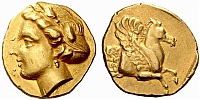
Lampsakos (BC 394-330) AV Stater - female1228 viewsca 330 BC. AV Stater (8.40g). Female head (Aphrodite?) left, wearing laurel of lotus flowers, hair caught up in saccos behind / Forepart of Pegasos right within very shallow incuse square.
Very rare. gVF. Ex Leu 42 (1987), 286 and NAC 27 (2004), 178. From the Waddington and Gillet collections and the duplicates of the Bibiothèque Nationale de France.
|
|
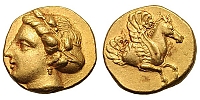
Lampsakos (BC 394-330) AV Stater - female1110 viewsca 400-370 BC. AV Stater (8.41g). Female head left, wearing sphendone in hair, wreath of lotus blossoms and ear pendant / Forepart of Pegasos right. EF.
|
|
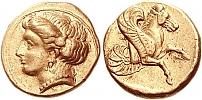
Lampsakos (BC 394-330) AV Stater - female1112 viewsCirca 394-350 BC. AV Stater (8.39g, 11h). Head of female left, wearing triple-pendant earring and necklace / Forepart of Pegasos flying right within shallow incuse square. Good VF, underlying luster. Struck from artistic dies. Extremely rare, one of only three known, the other two in museum collections (the BN and BM). Both the BN and BM specimens are struck from the same die pair. The present coin adds a new reverse die to the corpus.
|
|
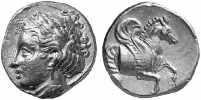
Lampsakos (BC 394-330) AV Stater - Hekate1488 viewsca 394-350 BC. AV Stater (8.38g, 17mm). Laureate head of Hekate left, wearing earring, korumbos in hair / Forepart of Pegasos flying right. Rare. Double strike on obv., aEF.
|
|
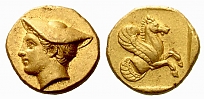
Lampsakos (BC 394-330) AV Stater - Hermes1877 viewsca 394-350 BC. AV Stater (8.39g). Head of Hermes left, wearing large brimmed causia / Forepart of Pegasus right within incuse square. Extremely rare. EF.
For the better part of 4th century BC, Lampsakos issued gold staters with forepart of Pegasus with a variety of obverse types. Few Greek cities were issuing gold at this time, and that Lampsakos was able to start such a project and maintain it for five or six decades, speaks volumes of its wealth and importance. Lampsakos had issued an important group of electrum staters in earlier times. Its gold staters apparently enjoyed wide distribution. Baldwin documented 41 issues of Lampsakene staters in her 1924 study, which is still the standard work. Of these, 8 bore figural types and 32 bore portraits, revealing a preference for the latter category. The chief difficulty Baldwin encountered in ordering the series was the surprising lack of die links between issues; in fact only once was a reverse die carried over from one issue to another, making a global die study impossible. For die studies within each issue, she located 5 examples of Hermes staters that were struck with 5 obverse and 4 reverse dies.
|
|
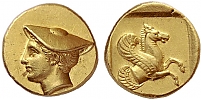
Lampsakos (BC 394-330) AV Stater - Hermes1737 viewsca 394-350 BC. AV Stater (8.41g). Head of Hermes left, wearing petasos / Forepart of Pegasus right within incuse square. EF.
|
|
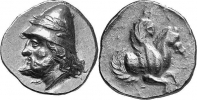
Lampsakos (BC 394-330) AV Stater - Kabeiros1438 viewsca 340 BC. AV Stater (8.47g, 7h). Head of bearded Kabeiros left, wearing laureate pilos / Forepart of Pegasos right. Extremely rare, one of only five known specimens, of which three are in museums. With an obverse of beautiful late classical style, struck in high relief and attractively toned. Reverse struck from the usual worn die, otherwise, extremely fine.
From the collections of C. Gillet, Bank Leu & Muenzen und Medaillen (Kunstfreund), 28 May 1974, 218, R. Jameson and Sir H. Weber, who purchased it from Alischan in Constantinople in 1889.
|
|
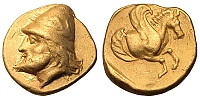
Lampsakos (BC 394-330) AV Stater - Kabeiros1386 viewsca 394-350 BC. AV Stater (8.38g). Head of bearded Kabeiros left, wearing laureate pilos / Forepart of Pegasos right. VF.
|
|
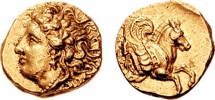
Lampsakos (BC 394-330) AV Stater - maenad1312 viewsca 394-350 BC. AV Stater (8.38g, 3h). Head of a Maenad left, hair flying, wearing ivy wreath, triple-pendant earring, and necklace / Forepart of Pegasos right in shallow incuse. Good VF, a few minor marks.
|
|
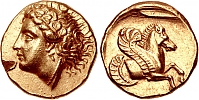
Lampsakos (BC 394-330) AV Stater - maenad1077 viewsca 394-350 BC. AV Stater (8.36g, 17mm, 12h). Head of female left, wearing ivy wreath, single-pendant earring and necklace / Forepart of Pegasos flying right within shallow incuse square. Near EF, test cut on edge. Good style and sharp details. Ex Gorny & Mosch 151 (10/2006), lot 174.
|
|
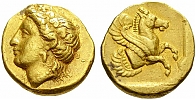
Lampsakos (BC 394-330) AV Stater - maenad822 viewsca 350-330 BC. AV Stater (19mm, 8.43g). Ivy-wreathed head of Maenad left, wearing ivy wreath, single-pendant earring and necklace / Forepart of Pegasos right within shallow incuse square. Very rare. aEF.
|
|
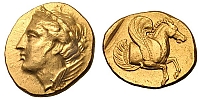
Lampsakos (BC 394-330) AV Stater - Nike812 viewsca 394-350 BC. AV Stater (8.43g). Laureate head of Nike left, wing attached to neck / Forepart of winged horse monster right. Somewhat softly struck on obverse. Extremely fine.
|
|
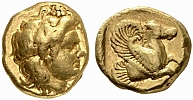
Lampsakos (BC 394-330) AV Stater - satyr882 viewsafter 380 BC. AV Stater (8.34g, 16mm, 9h). Head of a young satyr with ivy wreath right / front part of Pegasos right within incuse square. VF. Very rare.
|
|
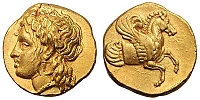
Lampsakos (BC 394-330) AV Stater - satyr1059 viewsca 360-340 BC. AV Stater (8.42g). Head of female (!) satyr with pointed ear and flowing hair facing left, wearing ivy wreath, ear pendant and necklace / Forepart of Pegasos right. Highly unusual and extremely beautiful. Less than five recorded specimens. Good EF.
|
|
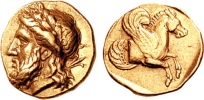
Lampsakos (BC 394-330) AV Stater - Zeus1501 viewsca 394-350 BC. AV Stater (8.56g, 4h). Laureate head of Zeus left; lotus flower behind / Forepart of Pegasos right in shallow incuse. Good VF. Rare.
|
|
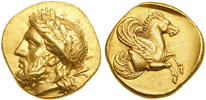
Lampsakos (BC 394-330) AV Stater - Zeus1623 viewsca 394-350 BC. AV Stater (8.51g). Laureate head of Zeus right, lotus flower behind at base of neck / Forepart right of curl-winged Pegasos in shallow incuse. Rare and of the best style! About Extremely Fine/ Choice Very Fine.
|
|

Persian Kings (BC 375-340) Daric255 viewsArtaxerxes II to Artaxerxes III, ca 375-340 BC. AV Daric (15mm, 8.33 g). Persian king or hero, wearing kidaris and kandys, quiver over shoulder, in kneeling-running stance right, holding dagger in right hand, bow in left / Incuse punch. Near EF, a few faint scratches in field on obverse, some earthen encrustation on reverse. Very rare. Sunrise Coll.
|
|
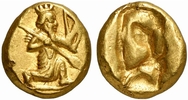
Persian Kings (BC 420-375) Daric1129 viewsca 420-375 BC. AV Daric (8.35g). Great King of Persia running right, wearing kidaris, holding bow in his left hand, spear with his right hand / Rectangular incuse. Insignificant knock on edge. Almost extremely fine.
|
|
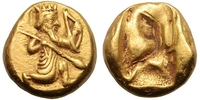
Persian Kings (BC 420-375) Daric2331 viewsAchaemenid Persia, ca 450-330 BC. AV Daric (8.30g). Great King running right, holding transverse spear in right hand and bow in left / Irregular rectangular incuse. Extremely fine. Displayed at Cincinnati Art Museum, 1994-2008, no. 69 (obverse illustrated in guide). Acquired from Harlan J. Berk, May 1995.
|
|

Persian Kings (BC 420-375) Daric199 viewsXerxes II to Artaxerxes II, ca 420-375 BC. AV Daric (14mm, 8.31g). Persian king or hero, wearing kidaris and kandys, quiver over shoulder, in kneeling-running stance right, holding spear in right hand, bow in left / Incuse punch. EF. Well centered and struck. Rare. Sunrise Coll.
|
|
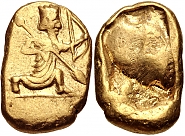
Persian Kings (BC 420-375) Daric446 viewsXerxes I to Artaxerxes II, ca 420-375 BC. AV Daric (12.5mm, 8.31g). Lydo-Milesian standard, Sardeis mint. Persian king wearing kidaris and kandys, quiver over shoulder, in kneeling running stance right, holding spear in right hand and bow in left / Incuse punch. Good VF, well centered and unusually well struck. Carr coll.
|
|
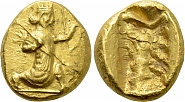
Persian Kings (BC 420-375) Daric222 viewsXerxes II to Artaxerxes II, ca 420-375 BC. AV Daric (16.88mm length, 15.10mm width, 3.49mm profile, 8.39g). Sardeis mint, Lydo-Milesian standard. Persian king wearing kidaris and kandys, quiver over shoulder, in kneeling running stance right, holding spear in right hand and bow in left / Rectangular wave-like patterned incuse. EF with luster, well centered and unusually well struck. Carr coll.
The reverse punch of this coin is uncommon for a Daric, but similar to that used for a Double Daric with its rectangular ‘wave-like’ patterned incuse.
|
|
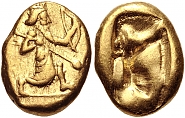
Persian Kings (BC 485-420) Daric300 viewsca 485-420 BC. AV Daric (13mm, 8.29g). Lydo-Milesian standard, Sardeis mint. Persian king wearing kidaris and kandys, quiver over shoulder, in kneeling running stance right, holding spear in right hand and bow in left / Incuse punch. gVF, well centered and struck. Carr coll.
|
|
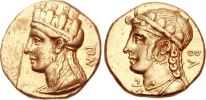
Salamis (BC 351-332) AV Stater - Pnytagoras960 viewsPnytagoras, King of Salamis, ca 351/0-332/1 BC. AV Stater (8.31g, 12h). Persic standard. Draped bust of Aphrodite left, hair rolled above forehead and falling in long wavy strands to front and back of shoulder, wearing beaded necklace, triple-drop earring, and turreted crown; Î N behind / Draped bust of Aphrodite left, hair in tight ringlets falling before ear and down back of neck, wearing torque (open end at front of her neck), beaded hoop earring, fillet, and crown decorated with semicircular plates; BA behind. EF, scratch in field on obverse. Very rare.
|
|
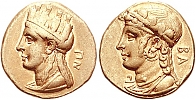
Salamis (BC 351-332) AV Stater - Pnytagoras721 viewsPnytagoras, ca 351-332 BC. AV Stater (8.26g, 10h). Persic standard. Draped bust of Aphrodite left, hair rolled above forehead and falling in long wavy strands to front and back of shoulder, wearing beaded necklace, triple-drop earring, and turreted crown, Î N behind / Draped bust of Aphrodite left, hair in tight ringlets falling before ear and down back of neck, wearing torque (open end at front of her neck), beaded hoop earring, fillet, and crown decorated with semicircular plates; BA behind. VF, underlying luster, a few minor field marks. Very rare.
|
|

Salamis (BC 361-351) AV Stater - Evagoras II1659 viewsEvagoras II, King of Salamis, 361-351 BC. AV Stater (8.21g). Persic standard. Lion standing left on ground line, eagle perched left on its back, wings closed, looking back / Archer standing right, quiver on shoulder, holding notched arrow and about to draw bow, ΕΥΑ to left. Near EF, a few minor marks, well centered. Unique and unpublished.
A total of five gold staters of Evagoras II were previously known, of three different varieties. The reverse of the present piece is a previously unknown design for Evagoras, an archer about to draw his bow, instead of the bust of Aphrodite.
|
|
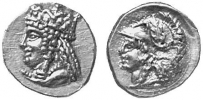
Salamis (BC 373-361) AV 1/12 Stater - Nikokles710 viewsNikokles, King of Salamis, 373-361 BC. AV 1/12th Stater (0.68g). Head of Aphrodite left / Head of Athena left, wearing Corinthian helmet. aEF.
|
|

Salamis (BC 411-373) AV 1/10 Stater - Evagoras I1710 viewsEvagoras I, King of Salamis, 411-374/3 BC. AV Tenth Stater (0.74g, 1h). Persic standard. Bearded head of Herakles right wearing lion's skin headdress / Forepart of goat kneeling right on club. Good VF.
|
|
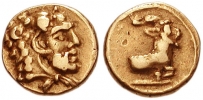
Salamis (BC 411-373) AV 1/10 Stater - Evagoras I927 viewsEvagoras I, King of Salamis, 411-374 BC. AV 1/10th Stater (8mm, 0.70g). Bearded head of Herakles right wearing lion's skin headdress / Forepart of goat kneeling right. VF. Rare.
|
|

Salamis (BC 411-373) AV 1/4 Stater - Evagoras I837 viewsEvagoras I, King of Salamis, 411-374 BC. AV 1/4 Stater (2.01g). "UÂvaÂkoÂro" in Cypriot characters, youthful head of Herakles wearing lion’s skin headdress, facing threeÂ-quarters left/ "PaÂsiÂleÂwoÂse" in Cypriot characters, goat lying right. Apparently only the second specimen known. Good extremely fine.
|
|

Uncertain (BC 425-375) AV516 views4th century BC. AV (17mm, 3.44g, 5h). Forepart of boar right / Forepart of lion right. Near EF, traces of deposits in devices, a couple of minor field marks. Unique.
This puzzling coin is clearly in the same series as a small group of silver fractions of identical types and style that have trickled onto the market over the past five years with weights averaging 1.12g. Although the types suggest an origin in Asia Minor (e.g. Kyzikos), anecdotal information suggests an area further east in the region of Baktria. The weight is also mysterious - it does not seem to bear any clear relationship to the weight standards prevalent in the eastern Mediterranean, but is almost exactly three times the weight of the silver fractions, suggesting that the coins may have been intended to circulate locally in a closed exchange area rather than as part of the international financial system. The unusual weight on an apparent local standard supports the suggestion that this issue should be attributed to some region in central Asia remote from western commerce.
|
|
|
|
|
|
|

|
